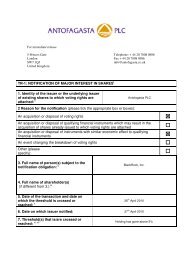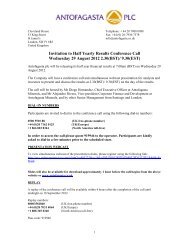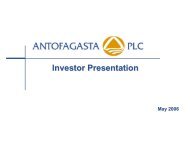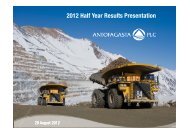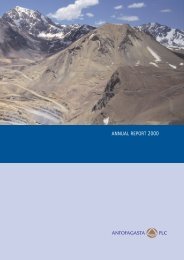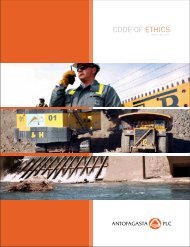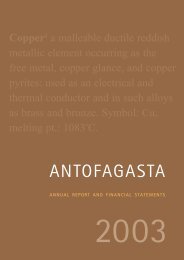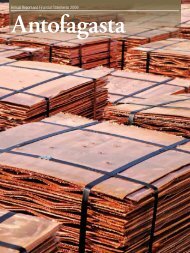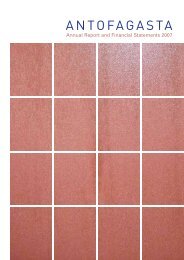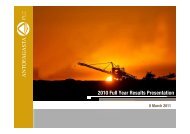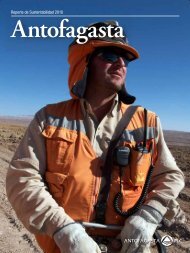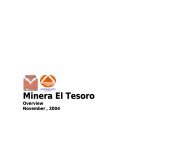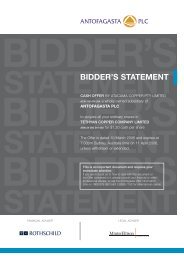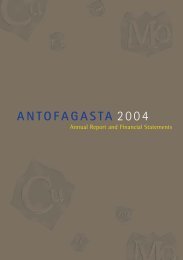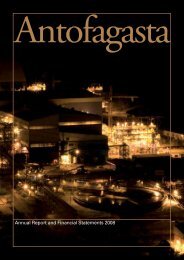Sustainability Report - Antofagasta PLC
Sustainability Report - Antofagasta PLC
Sustainability Report - Antofagasta PLC
You also want an ePaper? Increase the reach of your titles
YUMPU automatically turns print PDFs into web optimized ePapers that Google loves.
Water<br />
Our approach<br />
Using water efficiently and recycling it wherever possible is a central concern<br />
for the mining operations. All of our mines have water management plans in<br />
place and they strive to use water efficiently and recycle or reuse it. Our<br />
operations recycle up to 85% of the water used in their processes through a<br />
system of industrial water recirculation. The rest is lost either through<br />
evaporation or from being trapped in tailings or waste ore.<br />
The mining companies monitor the quantity and quality of the water they use<br />
and report on these key performance indicators every month. This is one of<br />
the KPIs that affect each company’s bonus. The mines also ensure that<br />
emissions of wastewater meet quality standards.<br />
To reduce demand on surface and groundwater sources <strong>Antofagasta</strong><br />
Minerals has pioneered the use of sea water in the mining process in Chile.<br />
Michilla began using non-desalinated sea water in the 1990s and, on a<br />
much larger scale, Esperanza also operates using non-desalinated seawater.<br />
We have recently approved the Antucoya project to operate using nondesalinated<br />
sea water.<br />
As both water availability and water quality are important social issues, each<br />
mining company engages with local communities to understand their<br />
concerns and evaluates how to reduce its impact on local water demands.<br />
This is most relevant for Los Pelambres, as it is situated within an<br />
agricultural valley. In 2011 it relocated one of its surface water intakes so<br />
that from 2012 it will be able to collect water from the naturally lower quality<br />
upper section of the Pelambres river. This will improve the quality of water<br />
downstream which is used by the local communities. El Tesoro continues to<br />
collaborate with the water authority to collect information to better<br />
understand and manage the Calama wellfield.<br />
<strong>Antofagasta</strong> Minerals 53<br />
What is the issue?<br />
Water is a key input for mining and mineral<br />
processing. All of our operations are in waterstressed<br />
regions. Three of our mines operate in the<br />
extremely arid conditions of the Atacama desert. The<br />
fourth one is situated at the source of an agricultural<br />
valley.<br />
<strong>Antofagasta</strong> Minerals’ main challenge is to operate<br />
and to grow sustainably by preventing and controlling<br />
the impact of our activities and being efficient in the<br />
use of natural resources.<br />
When using surface and groundwater, we have<br />
strong water management programmes to recirculate<br />
water and to intensively monitor basin water quality<br />
and quantities (flows and levels). We have also<br />
pioneered the use of alternative water sources.<br />
Michilla has used seawater since the 1990s and our<br />
newest operation, Esperanza, was built to operate<br />
using non-desalinated seawater.<br />
In the longer term, climate change is likely to have an<br />
impact on the freshwater resources in Chile, with<br />
changes in precipitation and increased temperatures,<br />
predicted to reduce the availability of water.<br />
Overview<br />
<strong>Sustainability</strong> at <strong>Antofagasta</strong> <strong>Antofagasta</strong> Minerals <strong>Antofagasta</strong> Antofaga Railway Company Aguas de <strong>Antofagasta</strong> Appendices



